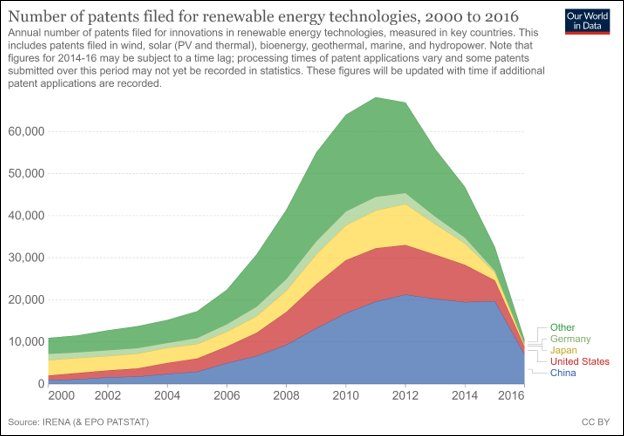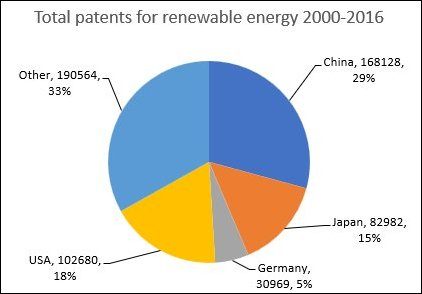Click here for the Concept Note Applications to be accepted until May 10, 2025, 23:59…
Who Controls Renewable Energy Technology? C. P. Chandrasekhar and Jayati Ghosh
As the earth warms up to increasingly unlivable temperatures, it is clear that fossil fuel energy sources will have to be abandoned as fast as possible, even though most governments today are extraordinarily slow to move decisively on this. Clearly, renewable energy sources have to be the basis for any feasible future for human life on this planet. And this means that who or rather, which countries and which corporations—control the technologies for renewable energy use, is going to become an absolutely critical question very quickly.
At present, renewable energy accounts for only around 12 per cent of all energy sources in the world as a whole. And, as Figure 1 indicates, it is still dominated by hydro power. It is true that wind and solar energy have grown exponentially in the two decades since 2000, but the absolute increase in hydro power is still larger over this period, and in 2020 it accounted for 58 per cent of all renewable energy generation.
Figure 1

Source: https://ourworldindata.org/renewable-energy#breakdown-of-renewables-in-the-energy-mix
It may seem surprising that the shares of solar and wind power in total renewable energy still remain so small, given the hype around them, the possibility of so many countries being able to benefit from the sun and wind, and the fact that these sources of power are now competitive in price terms with fossil fuels. This is largely because using more of these sources requires more than developing these as sources of power generation; it also requires a great deal of complementary infrastructure, including for storage and distribution, which in turn requires large scale investment. Currently, only China appears to be enabling levels of investment in this at anything like what is required. Even the rich countries are lagging far behind in this, while most low and middle income countries are nowhere near the levels of investment that would enable them to make such an energy transition.
But in addition to the complementary infrastructure, another critical dimension is the access to the required technologies. And this is where the stranglehold of intellectual property rights and the monopolization of knowledge by a few countries and corporations can and does prevent the greater spread of renewable energy use.
Figure 2

Source: https://ourworldindata.org/search?q=patents+for+renewable+energy+technologies, accessed on 14 May 2022
In the first half of the first decade of this century, when renewable energy technologies began to be recognized as being important, they were dominated by a few countries of the Global North, particularly Germany, Japan and the United States. But from around 2005 onwards, China began to be a major player in developing renewable energy, particularly solar and wind sources. This was driven by a combination of public investment in R&D and in related infrastructure investments, direct subsidies and credit guarantees provided to producers of solar and wind energy.
This was so effective, and done at such a scale, that it was instrumental in driving down costs to the point that solar and wind energy sources became cost competitive with older fossil fuel energy sources at the global level. (India also became a more important developer of such technologies and production over this period.) However, instead of celebrating what should be seen as a win for humanity and the planet, the USA actually brought cases against China and India in the World Trade Organization, arguing that their subsidies to these sectors constituted a breach of the global trade rules.
As evident from Figure 2, globally the peak period of patenting renewable energy technologies was 2008 to 2014—and it was also the period when, in addition to China and the earlier large players US, Germany and Japan, several other countries like the Republic of Korea and France showed increased patenting activity. This confirms the analysis in a study from WIPO (https://www.wipo.int/edocs/pubdocs/en/wipo_pub_econstat_wp_44.pdf) which found that for the world as a whole, energy innovation-related patenting expanded exponentially up until 2013, but was then followed by a period of deceleration, even a slow decline. This was most pronounced in nuclear power generation technologies, in solar and wind energy, and in fuel cells. By contrast, patenting in some related green technologies in energy conservation and green transportation continued to grow, although more slowly.
Why did the pace of patenting of renewable energy technologies decline after 2014? There are several features of such technologies which make them at once more accessible to developing countries and more complicated to ensure full knowhow and transfer of technology. To begin with, the basic technologies involved in both solar and wind energy have been off-patent and fairly widely known for years now, making them more in the category of “routine” technologies that are universally accessible. Most of the patents therefore involve only incremental improvements, and many of these can effectively be designed around. As a result, no single patent can block an entire technology or prevent some other producer from entering the market. However, full technology transfer requires more than the ability to override or ignore a patent, as will be evident below.
The pattern of R&D spending and other investments in the major countries that was observed in Figure 2 has meant a serious concentration of knowledge relating to green energy sources in the world as a whole. As Figure 3 indicates, just three countries—the USA, China and Japan—accounted for 62 per cent of all the renewable energy patents awarded in the period 2000-2016. Since then, the share of China has grown even more, so that it now accounts for around one-third of all such patents. Such concentration can be of concern to other nations, especially low and middle income countries, as it becomes increasingly evident that in addition to profit orientation of large companies, geopolitical considerations can affect economic relationships and knowledge transfers even when they are necessary to save the planet.
Figure 3

Source: https://ourworldindata.org/search?q=patents+for+renewable+energy+technologies, accessed on 14 May 2022
The bigger complication for other countries comes not from patents alone, but from trade secrets, which have emerged as major elements for production success in this activity. Trade secrets refer to processes of implanting, improving and adapting patented technologies, typically covering tacit knowledge and knowhow that can be critical to adapt green technologies to specific local conditions.
It can be difficult to force the transfer of this tacit knowledge as there is no legal mechanism to enforce it. However, legal mechanisms do exist to prevent such tacit knowledge from being used, and rich country governments have not hesitated from using these to prevent the dissemination of green technology. For example, the US government took action against Chinese renewable energy companies, claiming that they had appropriated what were seen to be “proprietary trade secrets” of the US companies SolarWorld and the American Superconductor Corporation. (https://metispartners.com/thought-leadership/the-role-of-ip-rights-in-green-technologies-innovation/)
Despite this, China’s investments in R&D for renewable energy have put it at the forefront in terms of both knowledge and production. Today it is the world’s largest producer of solar panels, wind turbines, batteries and electric vehicles. It is also the largest investor in clean energy, both for the domestic market and for exportable items, and has also invested in clean energy projects in many parts of the developing world, including in South and Southeast Asia. (https://www.greenpeace.org/international/press-release/23446/chinese-equity-investments-in-energy-reshape-south-and-southeast-asia-greenpeace-analysis/)
There are other aspects of the likely future demand for renewable energy that are impacted by geographical concentration. China currently provides more than 85 per cent of the world’s rare earths, which are critical for many materials required for the green transition, and around two-thirds of the global supply of rare metals and minerals like antimony and baryte, which are all essential for the manufacture of electric car batteries, satellites, weapons, wind turbines and solar panels. These will also increasingly command both economic and strategic attention as the urgency of ensuring the shift away from fossil fuels becomes evident to more governments.
In many ways, it appears as though too many governments are simply ignoring or reacting only passively to one of the most significant challenges of our time. The behaviour of just a few major global players is therefore likely to shape not only the future of the world but the future power relations within it.
(This article was originally published in the Business Line on May 16, 2022)
